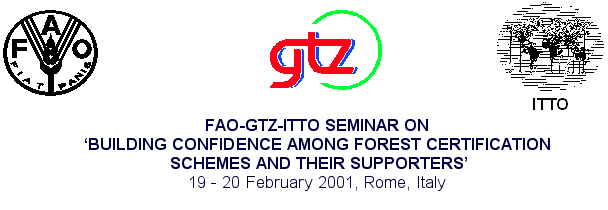



|
Current status and experiences of co-operation and efforts towards mutual recognition PEFC/01-00-01 The PEFC Council Experience Presentation by Ben Gunneberg Secretary General FAO-GTZ-ITTO Seminar, Rome, Italy: 19/20 February 2001 |
Areas to be covered re
|
Key points re PEFCC MRFRAMEWORK FOR ESTABLISHMENT OF COMPATIBLE NATIONAL FOREST
CERTIFICATION SCHEMES USES EXISTING STUCTURES REMAINS INDEPENDENT BOTTOM UP PROCESS STRUCTURE ENSURES DEMOCRATIC INPUT
|
Basis for Forest Certification Criteria
|
Continuous Process
|
Structure of PEFC as MR Process· Each country has a National Governing Body to which all stakeholders are invited to participate · Each country can apply to become a member of the PEFC Council and can submit its scheme(s) for assessment · Each country has votes according to FAO statistics · Countries vote in Council, as highest decision making body, including votes on endorsement of schemes · Countries elect Board, who appoints Secretariat.
|
|
|
|
|
Key Points· Schemes developed to common framework · Public consultation · Stakeholder involvement · Independent assessment
|
Experience and Current Status· 5 schemes endorsed · Account for 32.47 Million Hectares · 3 Schemes in pipeline · 5 more schemes
expected by end of 2001
|
Labelling Mechanism
Labelling mechanism now operational and available to those who require it covering: - National Schemes - Chain of Custodies |
|
Challenges
· New schemes developed by other political processes interested in PEFC · Options being considered include colleges of political processes to expansion of current PEFC structure to accommodate new applicants · Need to ensure Quality of schemes, subsidiarity principle and use of existing structures
|
Summary of Key Issues· Must be based on existing and normal procedures eg Processes for standard setting; national accreditation bodies and certification bodies · Bottom up approach which is voluntary, inclusive, transparent and respects subsidiarity · Non discriminatory and democratic process · Processes which are : · Label providers must be independent of accreditation and certification bodies and should be owned by members schemes to ensure no undue influence.
|
Conclusions
PEFC·
Respects political processes supported by multi-stakeholder
involvement
|